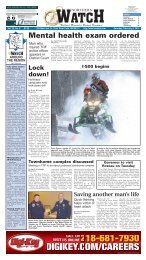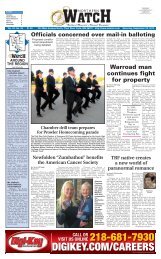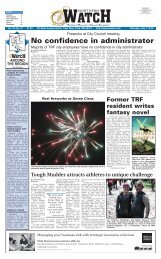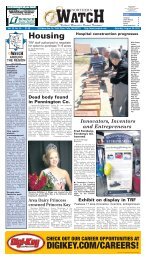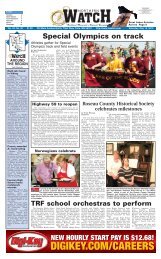Municipal Liquor $ - Thief River Falls Times & Northern Watch
Municipal Liquor $ - Thief River Falls Times & Northern Watch
Municipal Liquor $ - Thief River Falls Times & Northern Watch
You also want an ePaper? Increase the reach of your titles
YUMPU automatically turns print PDFs into web optimized ePapers that Google loves.
Page 10 NORTHERN WATCH Saturday, April 6, 2013<br />
<strong>Municipal</strong> <strong>Liquor</strong> $<br />
Troy Larson from Great Lakes Gas is pictured<br />
with one of the retired utility poles<br />
that was recently installed. An American<br />
(Continued from Page 1)<br />
sale liquor store had a gross<br />
profit of $166,250; operating<br />
expenses of $189,464; and<br />
operating income of a loss of<br />
$23,214. Its net profit was a<br />
loss of $19,291. It transferred<br />
no money to other<br />
funds.<br />
• <strong>Thief</strong> <strong>River</strong> <strong>Falls</strong>’ offsale<br />
liquor store had a gross<br />
profit of $987,225; operating<br />
expenses of $589,665; and<br />
operating income of<br />
$397,560. Its net profit was<br />
$411,319, and it transferred<br />
$362,835 to other funds.<br />
• Warroad’s off-sale liquor<br />
store had a gross profit of<br />
$347,580; operating expenses<br />
of $212,915; and operating<br />
income of $134,665. It<br />
had a net profit of $137,332,<br />
and it transferred $85,000 to<br />
other funds.<br />
Minnesota municipalities<br />
were originally authorized<br />
to own and operate liquor<br />
establishments as a means<br />
of controlling the sale of<br />
alcohol. For many communities<br />
in Greater Minnesota,<br />
municipal liquor operations<br />
provide access and convenience<br />
in areas that might be<br />
unable to attract a privatelyrun<br />
establishment. In addition<br />
to these functions, profitable<br />
municipal liquor operations<br />
have provided another<br />
source of revenues to supplement<br />
traditional tax and<br />
fee revenues.<br />
Highlights from the<br />
report include:<br />
• The combined net profit<br />
of all municipal liquor<br />
operations totaled $23.4 million<br />
in 2011. This represents<br />
an increase of $1.7 million,<br />
or 8.0 percent, over the<br />
amount generated in 2010.<br />
Among on-sale operations,<br />
net profits totaled $2.6 million<br />
in 2011, which was an<br />
increase of $598,468, or 30.3<br />
percent, over 2010. Total net<br />
profits for off-sale operations<br />
totaled $20.8 million in<br />
2011, which was an increase<br />
of $1.1 million, or 5.8 percent,<br />
over 2010.<br />
• During 2011,<br />
Minnesota’s municipal<br />
liquor stores transferred<br />
$20.1 million of their profits<br />
to other city funds. This represents<br />
an increase of 20.8<br />
percent over the total net<br />
transfers made in 2010.<br />
Transfers totaled $6.5 million<br />
among metro area<br />
establishments, compared to<br />
$13.6 million for Greater<br />
Minnesota establishments.<br />
• During 2011,<br />
Minnesota’s municipal<br />
liquor operations reported a<br />
16th consecutive year of<br />
record sales totaling $317.2<br />
million. Total sales generated<br />
in 2011 increased by $3.8<br />
million, or 1.2 percent, over<br />
2010.<br />
• Over the past five years,<br />
net profits have increased<br />
4.4 percent. Among off-sale<br />
stores, there was a 6.5 percent<br />
increase in net profits,<br />
while on-sale stores showed<br />
a decrease of 9.9 percent.<br />
• Thirty-six Minnesota<br />
cities reported net losses for<br />
2011, compared to 40 cities<br />
in 2010. All 36 cities with<br />
losses were from Greater<br />
Minnesota.<br />
• Minnesota law requires<br />
cities to hold a public hearing<br />
on the future of their<br />
liquor store(s) if the liquor<br />
operation shows a net loss in<br />
at least two of the past three<br />
years. While this report is<br />
based on 2011 data, an<br />
examination of losses for the<br />
years 2009, 2010 and 2011<br />
shows that 30 cities should<br />
have held hearings on or<br />
after Nov. 17, 2011. Of the 30<br />
cities required to hold a<br />
hearing in 2011, 22 were on<br />
the previous year’s list.<br />
kestrel nesting box is attached to the pole.<br />
(Submitted)<br />
Agassiz Audubon recruits bird nest watchers<br />
Before the snow started to<br />
melt, PKM Electric<br />
Cooperative lineworkers<br />
spent a morning installing<br />
three “retired” utility poles<br />
in rural Kittson County. The<br />
poles will hold nest boxes<br />
designed specifically to<br />
attract North America’s<br />
smallest and flashiest falcons<br />
– the American kestrel.<br />
American kestrels, also<br />
known as sparrow hawks,<br />
are about the size of a blue<br />
jay. Kestrels used to be a<br />
common sight – perched on<br />
power lines and poles along<br />
roads adjacent to farm fields<br />
and grasslands. Scientists<br />
believe the lack of suitable<br />
nesting cavities may be a<br />
limiting factor for these<br />
birds in Minnesota.<br />
Last year, PKM installed<br />
10 poles at the Audubon<br />
Center near Warren. “We<br />
had five nestlings fledge<br />
from one of those boxes, and<br />
students who participated in<br />
the WAO summer camp got<br />
to help Tim Driscoll band<br />
them. We are grateful for<br />
PKM’s help again this<br />
spring,” said Heidi Hughes,<br />
director of Agassiz<br />
Audubon’s Community Nest<br />
<strong>Watch</strong> Project.<br />
The Kittson County<br />
Community Nest <strong>Watch</strong><br />
project started in December,<br />
when Wes Johnson, the shop<br />
teacher at Kittson Central<br />
High School, contacted<br />
Agassiz Audubon with an<br />
offer to build bird nest<br />
boxes. Hughes accepted the<br />
offer and recruited volunteers<br />
in Kittson County to<br />
install and monitor the<br />
boxes. Donations from the<br />
Kennedy Crew and the<br />
Hallock Eagles Club covered<br />
the cost of the wood.<br />
Johnson’s ninth grade shop<br />
class built more than a<br />
dozen boxes. Then PKM<br />
donated the poles and<br />
offered to install them in its<br />
service area. Ottertail Power<br />
will be installing eight additional<br />
poles and boxes soon.<br />
Agassiz Audubon is looking<br />
for volunteers to help<br />
watch the nest boxes in the<br />
following locations in northwestern<br />
Minnesota:<br />
• Kennedy: the ball<br />
field, the Kennedy water<br />
tower<br />
• Hallock: 12th Street<br />
South, the fairgrounds,<br />
Kittson Central High School<br />
• Hampden Township:<br />
Orleans Grain Elevator<br />
(312th Street)<br />
• Clow Township:<br />
Great Lakes Gas<br />
Transmission station, North<br />
Kittson Rural Water Tower<br />
and Viking Gas<br />
Transmission Humboldt<br />
Compressor Station<br />
• Lancaster: Lancaster<br />
Public School Practice Field<br />
• Norway Township:<br />
Carlson Prairie Seeds<br />
• Brislet Township:<br />
Audubon Center and<br />
Agassiz Valley Project<br />
(impoundment)<br />
• Viking Township:<br />
Enbridge Energy<br />
• Angus: Viking Gas<br />
Transmission<br />
• Lincoln Township:<br />
420th Street<br />
Agassiz Audubon Society<br />
is recruiting nest box sponsors<br />
and volunteers. To participate<br />
– or to learn more<br />
about these birds – Agassiz<br />
Audubon will present programs<br />
in April and May at<br />
libraries in Hallock,<br />
Greenbush, Roseau,<br />
Warroad, Warren, <strong>Thief</strong><br />
<strong>River</strong> <strong>Falls</strong>, Red Lake <strong>Falls</strong><br />
and East Grand Forks.<br />
For more information,<br />
call 218-745-5663, email<br />
AgassizAudubon@gmail.com<br />
and take a look at the<br />
Agassiz Audubon Facebook<br />
page: at www.facebook.<br />
com/AgassizAudubon.<br />
This is an American kestrel<br />
chick. Nest boxes have<br />
been installed in the area<br />
for American kestrels.<br />
(Submitted)<br />
The Badger High School robotics team<br />
recently competed in Duluth. Team members<br />
included (front row) Madi Trucinski,<br />
Katie Coltom, Emily Hamann, Katie Rhen,<br />
Kellie Parnow; (middle row) Alex Burkel,<br />
Cody Madoll, Alex Trucinski, Riley Sovde,<br />
Tyler Klegstad, Robby Davy; (back row)<br />
Kasey Wojciechowski, Jacob Randall,<br />
Christian Kilbride, Cole Hamann, Seth<br />
Christenson, Tanner Creviston and Logan<br />
Klegstad. (Submitted)<br />
Badger robotics team competes in Duluth<br />
by Tanner Creviston and<br />
Seth Christenson<br />
On Wednesday, March 6,<br />
nearly 100 teams took over<br />
the Duluth Entertainment<br />
Convention Center to show<br />
off what six weeks of preparation<br />
had produced. Teams<br />
came from all over<br />
Minnesota and the surrounding<br />
states. Among the<br />
teams was the Badger High<br />
School robotics team, which<br />
placed 24 out of the 45 teams<br />
competing.<br />
The challenge was<br />
launching and/or dumping<br />
Frisbees into a variety of<br />
goals and then climbing a<br />
steel-pipe pyramid. Each<br />
match consisted of two<br />
teams of three who would<br />
try to out-score their opponents<br />
to bring their<br />
“alliance” a victory. Teams<br />
also had to be aware of illegal<br />
actions such as hitting a<br />
robot in the safe zone<br />
because the opposite team<br />
would then be awarded foul<br />
points.<br />
Friday and Saturday<br />
qualification rounds determined<br />
what seed each team<br />
would be going into<br />
Saturday afternoon. The top<br />
eight teams advanced automatically<br />
to the finals. The<br />
top eight teams also draft<br />
two additional teams to be<br />
on their “alliance.” This<br />
allows more than just the<br />
top eight teams to keep competing.<br />
After the alliances<br />
are formed they compete<br />
until the competition is<br />
down to two alliances.<br />
The Badger team was<br />
comprised of 20 students in<br />
grades 9 through 12, which<br />
is about 25 percent of the<br />
high school student body.<br />
Over the past three years,<br />
the number of robotics team<br />
numbers has been rising<br />
slowly. Because of the constant<br />
encouragement to try<br />
new things, the outlook for<br />
the robotics team is looking<br />
good. The team goal this<br />
year was to build a robot<br />
that could consistently score<br />
around 20 points per round.<br />
After a few failed attempts<br />
to create a robot that would<br />
successfully shoot the<br />
Frisbees, we stumbled upon<br />
what would later become our<br />
robot.<br />
One of our team captains,<br />
Seth Christenson, jokingly<br />
said, “We should just make a<br />
dump truck.”<br />
Little did he know that<br />
the majority of us took him<br />
seriously, so we started putting<br />
together a dump truck.<br />
We went with the basic twolevel<br />
rectangular frame; our<br />
drive system was powered<br />
by belts with two motors on<br />
each side. For the first time<br />
in Gator history, we used<br />
pneumatics (compressed air)<br />
to power our gate on the<br />
dump box to adjust the tilt<br />
on our dump box and to<br />
power the lifter, so the robot<br />
could hook the pyramid. The<br />
robot was completed with<br />
the addition of a diamondplate<br />
truck cab that covered<br />
our electrical components.<br />
At the competition, we<br />
were ready for the practice<br />
rounds, and the robot was<br />
performing how we envisioned<br />
with only a few problems.<br />
The first problem was<br />
the hooks were set too high<br />
to touch the bottom of the<br />
pyramid because the pyramids<br />
were shorter than we<br />
had thought. We solved the<br />
problem by shortening the<br />
hooks. The only other serious<br />
problem we encountered<br />
was that one of the controllers<br />
quit working, so we<br />
had to break out the spare.<br />
Throughout the competition,<br />
we performed very consistently,<br />
placing 24 out of the<br />
45 teams.<br />
This was the best placement<br />
that we have had in<br />
our three seasons, but it<br />
wasn’t enough to be picked<br />
into one of the final<br />
alliances. Even though our<br />
team didn’t win or be picked<br />
to a winning team, we still<br />
met or exceeded the goals we<br />
had set for ourselves, which<br />
is just about as good as a<br />
win.<br />
Team morale has been<br />
high post-season, and plans<br />
are already being made for<br />
improvements to the robot.<br />
All of the excitement created<br />
could not have been accomplished<br />
without the support<br />
of the Badger community<br />
and sponsors, and the hard<br />
work by the students.<br />
Here is the robot designed by the Badger High School<br />
robotics team. The team recently competed in Duluth.<br />
(Submitted)<br />
PKM Electric recently installed three retired<br />
utility poles in rural Kittson County. The<br />
poles feature American kestrel nesting<br />
boxes. (Submitted)<br />
Wes Johnson’s ninth grade shop class at<br />
Kittson Central High School built more than<br />
a dozen American kestrel nesting boxes<br />
that have been installed in the area.<br />
(Submitted)



